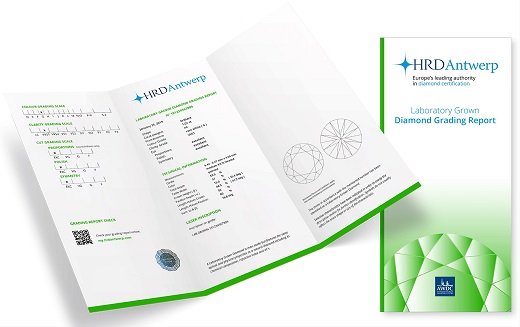HRD Makes Key Changes to Lab-Grown Reports
 RAPAPORT... HRD Antwerp has changed the language it uses in itslab-grown-diamond certificates to match its reports for natural stones. The grading lab, which has issued documents for loose synthetics since 2013, has expanded its color categories for lab-grown diamonds, andhas updated its 4Cs terminology to correspond with the certificates it issuesfor mined diamonds. While the old lab-grown-diamond certificate featured five color grades, ranging from light to colorless, the new version lists 13, with D as the highest grade, and S-Z as the lowest. The new certificate also includes 10 clarity grades, ranging from loupe clean (LC) to P3 (referring to piqu?(C)), whereas the previous report's grades spanned from free of inclusions (FI) to included (I). The change, which is launching this week, follows an internal decision to supply customerswith the most accurate grading report possible, providing a "true" descriptionof the diamond, HRD noted. "The role of a grading laboratory is to be 100% impartial,and tell the consumer about the exact quality of the stone...[whether] lab-grown or natural," the spokesperson added. The Gemological Institute of America (GIA) also plans toupdate its reports for synthetic diamonds shortly, but hasn't said exactly how. The certificates alsofeature a limited number of color and clarity categories compared with the reports itissues for natural diamonds. Additionally, HRD plans to launch a lab-grown-diamond-jewelryreport, which will provide a general description of the jewelry, as well asdetails of all synthetic diamonds it contains and the metal it's made of, HRDsaid. The new report will beavailable in September. Image: HRD Antwerp's new lab-grown-diamond grading report. (HRD Antwerp)
RAPAPORT... HRD Antwerp has changed the language it uses in itslab-grown-diamond certificates to match its reports for natural stones. The grading lab, which has issued documents for loose synthetics since 2013, has expanded its color categories for lab-grown diamonds, andhas updated its 4Cs terminology to correspond with the certificates it issuesfor mined diamonds. While the old lab-grown-diamond certificate featured five color grades, ranging from light to colorless, the new version lists 13, with D as the highest grade, and S-Z as the lowest. The new certificate also includes 10 clarity grades, ranging from loupe clean (LC) to P3 (referring to piqu?(C)), whereas the previous report's grades spanned from free of inclusions (FI) to included (I). The change, which is launching this week, follows an internal decision to supply customerswith the most accurate grading report possible, providing a "true" descriptionof the diamond, HRD noted. "The role of a grading laboratory is to be 100% impartial,and tell the consumer about the exact quality of the stone...[whether] lab-grown or natural," the spokesperson added. The Gemological Institute of America (GIA) also plans toupdate its reports for synthetic diamonds shortly, but hasn't said exactly how. The certificates alsofeature a limited number of color and clarity categories compared with the reports itissues for natural diamonds. Additionally, HRD plans to launch a lab-grown-diamond-jewelryreport, which will provide a general description of the jewelry, as well asdetails of all synthetic diamonds it contains and the metal it's made of, HRDsaid. The new report will beavailable in September. Image: HRD Antwerp's new lab-grown-diamond grading report. (HRD Antwerp)